城市公示语的汉英翻译
- 格式:doc
- 大小:26.00 KB
- 文档页数:2
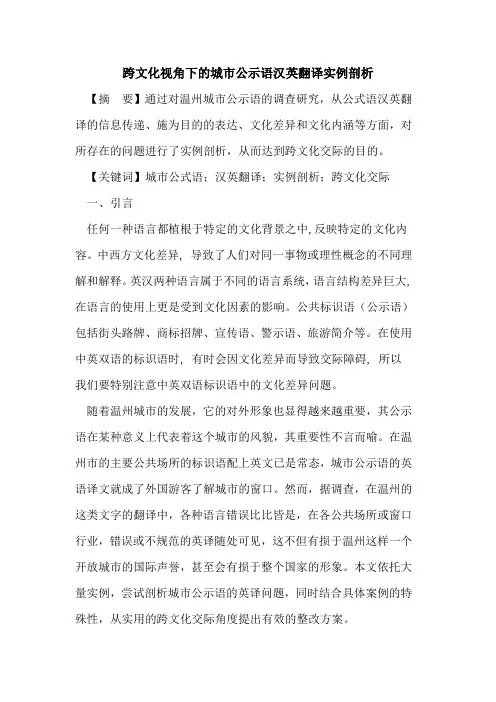
跨文化视角下的城市公示语汉英翻译实例剖析【摘要】通过对温州城市公示语的调查研究,从公式语汉英翻译的信息传递、施为目的的表达、文化差异和文化内涵等方面,对所存在的问题进行了实例剖析,从而达到跨文化交际的目的。
【关键词】城市公式语;汉英翻译;实例剖析;跨文化交际一、引言任何一种语言都植根于特定的文化背景之中,反映特定的文化内容。
中西方文化差异, 导致了人们对同一事物或理性概念的不同理解和解释。
英汉两种语言属于不同的语言系统,语言结构差异巨大, 在语言的使用上更是受到文化因素的影响。
公共标识语(公示语)包括街头路牌、商标招牌、宣传语、警示语、旅游简介等。
在使用中英双语的标识语时, 有时会因文化差异而导致交际障碍, 所以我们要特别注意中英双语标识语中的文化差异问题。
随着温州城市的发展,它的对外形象也显得越来越重要,其公示语在某种意义上代表着这个城市的风貌,其重要性不言而喻。
在温州市的主要公共场所的标识语配上英文已是常态,城市公示语的英语译文就成了外国游客了解城市的窗口。
然而,据调查,在温州的这类文字的翻译中,各种语言错误比比皆是,在各公共场所或窗口行业,错误或不规范的英译随处可见,这不但有损于温州这样一个开放城市的国际声誉,甚至会有损于整个国家的形象。
本文依托大量实例,尝试剖析城市公示语的英译问题,同时结合具体案例的特殊性,从实用的跨文化交际角度提出有效的整改方案。
二、实例剖析。
在温州街头巷尾的公示语汉英翻译中,主要出现以下几点问题。
未真实传递交际信息。
在温州茶山风景区,一个指示牌上把“咨询电话”和“投诉电话”分别译为“tourist consultation telephone”和“complaint telephone”。
在《牛津高阶英汉双解词典(第6版)》中,对telephone的解释为: a system for talking to sb else over long distance ,using wires or radios;a machine used for this. 意思为电话,电话机,与此处的“电话”有所不同。
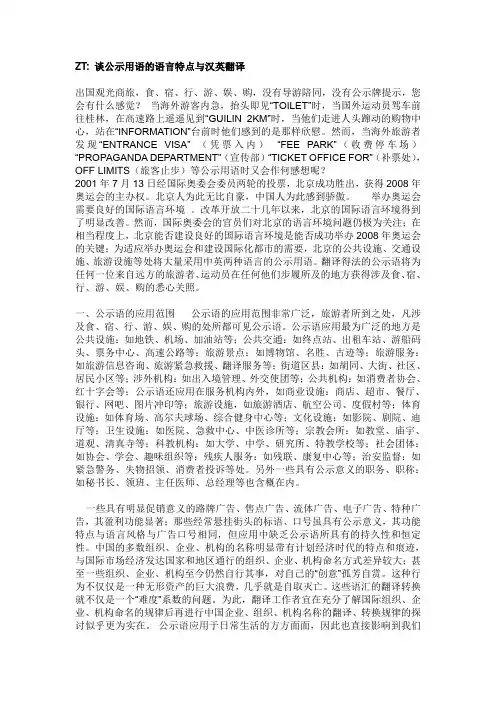
ZT: 谈公示用语的语言特点与汉英翻译出国观光商旅,食、宿、行、游、娱、购,没有导游陪同,没有公示牌提示,您会有什么感觉?当海外游客内急,抬头即见“TOILET”时,当国外运动员驾车前往桂林,在高速路上遥遥见到“GUILIN 2KM”时,当他们走进人头蹿动的购物中心,站在“INFORMATION”台前时他们感到的是那样欣慰。
然而,当海外旅游者发现“ENTRANCE VISA” (凭票入内)“FEE PARK”(收费停车场)“PROPAGANDA DEPARTMENT”(宣传部)“TICKET OFFICE FOR”(补票处),OFF LIMITS(旅客止步)等公示用语时又会作何感想呢?2001年7月13日经国际奥委会委员两轮的投票,北京成功胜出,获得2008年奥运会的主办权。
北京人为此无比自豪,中国人为此感到骄傲。
举办奥运会需要良好的国际语言环境。
改革开放二十几年以来,北京的国际语言环境得到了明显改善。
然而,国际奥委会的官员们对北京的语言环境问题仍极为关注;在相当程度上,北京能否建设良好的国际语言环境是能否成功举办2008年奥运会的关键;为适应举办奥运会和建设国际化都市的需要,北京的公共设施、交通设施、旅游设施等处将大量采用中英两种语言的公示用语。
翻译得法的公示语将为任何一位来自远方的旅游者、运动员在任何他们步履所及的地方获得涉及食、宿、行、游、娱、购的悉心关照。
一、公示语的应用范围公示语的应用范围非常广泛,旅游者所到之处,凡涉及食、宿、行、游、娱、购的处所都可见公示语。
公示语应用最为广泛的地方是公共设施:如地铁、机场、加油站等;公共交通:如终点站、出租车站、游船码头、票务中心、高速公路等;旅游景点:如博物馆、名胜、古迹等;旅游服务:如旅游信息咨询、旅游紧急救援、翻译服务等;街道区县:如胡同、大街、社区、居民小区等;涉外机构:如出入境管理、外交使团等;公共机构:如消费者协会、红十字会等;公示语还应用在服务机构内外,如商业设施:商店、超市、餐厅、银行、网吧、图片冲印等;旅游设施,如旅游酒店、航空公司、度假村等;体育设施:如体育场、高尔夫球场、综合健身中心等;文化设施:如影院、剧院、迪厅等;卫生设施:如医院、急救中心、中医诊所等;宗教会所:如教堂、庙宇、道观、清真寺等;科教机构:如大学、中学、研究所、特教学校等;社会团体:如协会、学会、趣味组织等;残疾人服务:如残联、康复中心等;治安监督:如紧急警务、失物招领、消费者投诉等处。
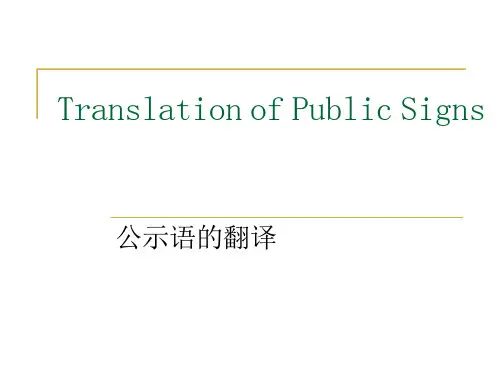
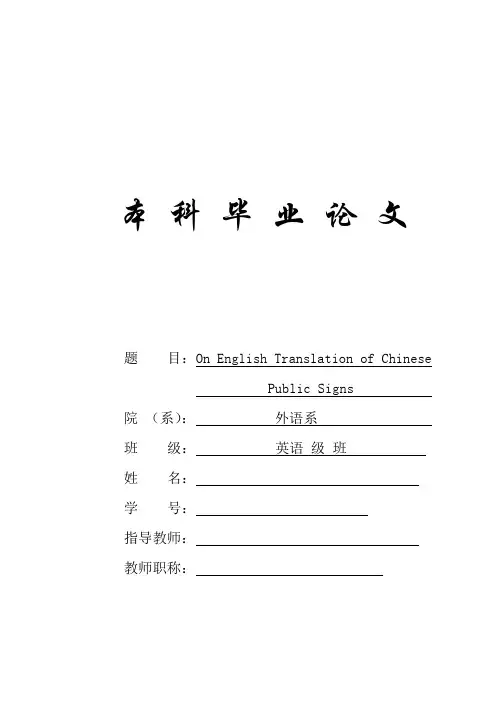
本科毕业论文题目:On English Translation of ChinesePublic Signs 院(系):外语系班级:英语级班姓名:学号:指导教师:教师职称:汉英公示语的翻译摘要公示语向来被称作“城市的脸孔",是给所有到中国来的外国人士留下第一印象的中国名片。
然而,公示语翻译的错误比比皆是,这大大影响了公示语作用的发挥,削弱了我国的国际形象。
为了树立我国良好的国际形象,不断规范和完善城市公示语的翻译成为了一项亟待完成的工作。
基于以上原因,作者尝试从理论和实践的角度分析现今汉英公示语翻译中所存在的一些问题。
通过对大量标准以及问题公示语翻译的深入观察分析,作者对公示语的一般特征进行了总结并对公示语翻译中出现的问题进行了分类,从而在实践观察和对相关理论深入研究的基础上提出相应的翻译策略。
翻译并不仅仅是跨语言行为,它更是一种文化信息的传递。
公示语的翻译同样如此。
得体的公示语翻译不仅在语言上要无懈可击,在文化信息传递上也要雅俗共赏。
本文还对公示语的概念做出了解释,并根据目的需求与功能两种标准对公示语做了分类。
在介绍公示语的特征时,作者将其分为语言特征与功能特征,特征与分类不同,也决定了需要采取不同的翻译策略。
关键词:汉英翻译;公示语;问题;翻译策略On English Translation of Chinese PublicSignsAbstractPublic signs, which have alway s been referred to “face of city”, are the first impression of China for the people who come to China. However, the ubiquitous translation mistakes of public signs greatly undermine the international image of China. So,specificating and constantly perfecting the translation of public signs have become an urgent work in order to establish a good international image.The paper ventures an attempt to analyze the current problems existing in the C-E translation of public signs and to seek proper translational strategies both from the perspectives of theory and practice.By closely observing numerous samples of both standard and problematic translation of signs,the author manages to generalize the characteristics of public signs and to categorize the problems and mistakes in the current C-E translation of public signs.Then, proper translational strategies are proposed on the basis of in-depth study of relevant theories and keen observation of practice.Translation is not merely a cross-linguistic activity, but more of a transmission of cultural information.The translation of public signs is no exception.An appropriate translation of public sign should not only belinguistically correct, but also culturally acceptable.This paper expresses the meaning of the public signs and classify the signs according to the standards of objective demand and function. And the characteristics of the public signs are different studied from linguistic features and functional features,which determines to adopt different translation strategies.Key words: Chinese-English translation public sign problems translation strategyContents摘要 (I)Abstract (II)CHAPTER I Introduction (1)1.1 O bjective of the study (1)1.2 Significance of the study (1)1.3 Structure of the paper (2)CHAPTER II General Introduction to Public Signs (3)2.1 Definition of Public Signs (3)2.2 Functions of Public Signs (3)2.2.1 Directing function (4)2.2.2 Prompting function (4)2.2.3 Restricting function (4)2.2.4 Compelling function (5)CHAPTER III Analysis on Problems in C-E Translation of Public Signs (6)3.1 Linguistic translation problems (6)3.1.1 Spelling errors (6)3.1.2 Grammatical errors (6)3.1.3 Wrong dictions (7)3.2 Cultural translation problems (7)CHAPTER IV Strategies of C-E Public Signs Translation and Requirementfor Translator (9)4.1 Principles of C-E translation of Public Signs (9)4.1.1 Clearness (9)4.1.2 Conciseness (10)4.1.3 Simple words (10)4.2 Methods of C-E translation of Public S igns (11)4.2.1 Modification (11)4.2.2 Addition (11)4.2.3 Omission (12)4.2.4 Mutual transformation of affirmative and negativee xpressions (13)4.3 Requirement for the t ranslators (13)CHAPTER V Conclusion (15)Acknowledgements (16)Works Cited (17)CHAPTER I Introduction1.1Objective of the studyThe research objective of the study is to examine the translation problems in the Chinese-English public signs translation and further propose the translation strategies as well as principles suitable for specific groups.The studies begin with the careful and long period of observation of the problems existing in the public signs translation. On the basis of the classification of the translation errors proposed by Christiane Nord, the author aims at the most appropriate translation strategies for each type. With the examination of sufficient sources, the author finds that it is not difficult to eliminate the errors at linguistic level since the text of the public signs is less complex than documentary and other instrumental texts due to its conciseness and directness features (Ni 18).1.2 Significance of the studyPublic S igns affect people’s life in a tremendous way. When somebody smokes, it is the public sign that stops him. In fascinating and mysterious spots where we have never been to, it is the public sign that teaches us related knowledge. Foreign visitors from all walks of life,such as entrepreneurs,professors,students and tourists come to China for various purposes.But for most of them,they know little about Chinese.In this case,it is necessary to translate Chinese public signs into English for the convenience of these foreign visitors.In this case, a proper translation helps establish a good image of China and enhance the cultural communication.1.3 Structure of the paperThe paper is structured with five chapters:The first chapter is a general introduction to the thesis, including the objective of the study, the structure of the thesis and the significance of the study. The second chapter makes a general introduction to public sign, including the definition and functions of public sign. The third chapter focuses on the problems of C-E translation of public signs from linguistics and cultural perspectives. The fourth chapter deals with translation strategies of C-E public signs in connection with principles, methods and the standardization for the translators, including modification, addition, omission and mutual transformation of affirmative and negative expressions. And the fifth chapter draws a conclusion to the paper,in which the author appeals for translators and scholars to make contributions to the C-E translation of public signs.CHAPTER II General Introduction to Public Signs2.1 Definition of Public SignsPublic Signs,which are usually called“signs”,include public notices,advertisements,slogans and expressions on the public signs.Public signs refer to “signs” in English and are defined in different ways.Ac cording to Longman Dictionary of Contemporary English(1997),a sign is a piece of paper, metal, or wood with words or a picture that gives information,warnings,or instructions.In that sense, public sign is the general terms for indicators,signs,traffic signs, posters, slogans, warning, short notices,short instructions,stickers,and are becoming the catch word and the buzzword.All in all, public signs are so widely used and played important roles in our daily life.2.2 Functions of Public SignsPublic signs are essential to the normal operation of the society and their influence is also visible in almost every aspect of our daily life.Sometimes,we have to admit that our lives cannot do without the proper guidance that public signs provide to us.However, what usually happens is that we are prone to be bewildered by various public signs and the enormous information they convey to us.Therefore, it would be necessary to classify the public signs in terms of their functions as well as the status of information that they deliver.2.2.1 Directing functionDirecting is the most basic function of public signs, t his type of public signs is used to give readers related information about what the institution is,what it deals with and what kind of service it can provide.For example:Take Away(外卖),Gas Station(加油站),Emergency Exit(紧急出口),Business Hours(营业时间),Pause(暂停),Menu(菜单),Airport Security(机场安检).From the examples above we may tell that the language and the tone of these public signs are generally neutral,reflecting no attitude towards receptors.Therefore,public signs of this kind are purely informative rather than vocative.2.2.2 Prompting functionPromoting signs are similar to the directive ones in their informative function. While the difference is the former .carries the tone of warning,reminding the readers to pay some attention to certain things or activities.For example:Keep Clear(请保持清洁), Keep Silence(请保持安静),Wet Paint(油漆未干),Fully Booked(客满),Beware of Pickpockets(小心扒手),Maximum Height(限高).2.2.3 Restricting functionPublic Signs with restricting function impose restriction or even prohibition on receptors.The language used in this kind of signs are simple and direct but are not in rude,tough or impolite way.We can list some of them as following:Pay In Cash(现金支付),Slow Out(减速慢行),Keep Silence(保持安静),30 Minutes Parking(限停30分钟),Seat By Number(对号入座), Stand In Line(排队等候).2.2.4 Compelling functionCompelling function is the strongest considerable mood.It is used to prohibit the readers to do something or must do something.The language used is usually forceful,with no possibility of making a compromise.The sign with this function which we mostly often see is“No Smoking禁止吸烟”,that is to say that smoking iscompletely forbidden.Imperative sentence is not enough to express this strong mood,usually, we use“No+…”form,for example,“No Food禁止携带食物”.More examples:Don’t Touch(禁止触摸),No Cameras(禁止拍照),No Visitors(游客止步),No Trucks(卡车禁止通行),Dogs Not Allowed(禁止带狗入内).Translation of the public signs, translators not only need to grasp their function features since we use different mood to express different function,but also should keep their language features in mind during the translating.CHAPTER III Analysis on Problems in C-E Translation ofPublic Signs3.1 Linguistic translation problemsLinguistic translation errors are often due to deficiencies in the translator's source or target language competence (Nord 77).And in his book Pragmatics and English Language He Ziran explained that by making linguistic errors,the translators and interpreters fail to conform to the target language structures,instead they blindly translate the source text in their own language structures(157).Professor Wang Yinquan, classifies linguistic translation errors into: spelling mistakes, grammar mistakes and wrong diction (32).3.1.1 Spelling errorsSpelling errors are typical translation problems in bilingual public signs. The reasons for this type of errors attribute to the three factors: the incompetent language acquisition, the laziness of the translator when writing, the uncertainty of the correct spelling, among which the third type is most difficult to be identified. For example: 3.1.2 Grammatical errorsApart from spelling mistakes,many grammatical errors also occur in the translated signs.These errors appear in various forms,most of which result from the translator’s poor command of the English language or irresponsible working attitude.As a result,the translated public signs cannot be of any help to the target readers.Sometimes they may do damage the image of our city.For example: 室内停车场(Car Park)—It may be apparent to tell that the translator intends to use the word“park”as a noun to express the meaning of parking place for automobiles.However, as a noun the word actually means a public place wherepeople can entertain themselves with the landscape or public facilities in it.Therefore, it will be advisable to use the gerund form of the word “park”and translate it as“Indoor Parking”.3.1.3 Wrong dictionsWrong Dictions occur when t he translator doesn’t make right choices of words in the target culture that will lead to unsuccessful expression of the correct information to the target text receivers. In fact, many English words have more than one meaning. Sometimes one word used to describe the source culture may not be applicable in another situation and the diction is conditioned. The words chosen for each text might vary according to different semantic and syntactic features in different situations. For example:请勿采摘花朵--Please Don’t Pick Flowers. Here use“pick”to describe the gesture. In fact, there is a variety of expression in English corresponding with “摘”, of which one of the expressions is “pick”. But in the given circumstances, “pick”doesn’t equate with “摘”. “Pick”means to select among a variety of choices, but here the sender wants to persuade people not to pluck the flowers. The error is due to the confusion about the seemingly identical usage of one word.3.2 Cultural translation problemsAs we all know, people in different cultures may view the same thing in different ways and differ in the perspective of cognition.At the same time,they express the same idea in different way.As far as Chinese and English are concerned, culture differences are tremendous.Translation breaks down language barriers and thus realizes communication between cultures using different languages. In this sense, target readers approach to people of source culture whose beliefs, backgrounds, perception of the world are distinct from their own.For example:古装照相It is ancient to pack photo“古装照相”is a typical Chinese term. In English, people don’t have the correspondent term. According to the public signs translation convention, the signs which are composed of Chinese noun phrases are expected to have the same structure in English version, so the sentence is not correct in terms of the sentence structure. Also concerning the meaning of the sentence, it is wrongly translated that the foreigners can’t get the message which leads to the pragmatic failure of the assumed function. The correct version should be “Photos in ancient costume”.CHAPTER IV Strategies for C-E Public Signs Translation4.1 Principles of C-E translation of Public SignsAs we know, different functions need different language forms to convey and each language style possesses its special principles.Ni Chuanbin and Liu Zhi analyze the language principles of public signs in their essay“The Principles for C-E Translation of Public Signs and its Cases Study”,published in Shanghai Journal of Translators for Science and Technology(18).Firstly, the signs are on a board,so the language on the signs should be in concise way due to the comparatively small space.Secondly, some public signs must draw the public’s attention at the first sight and the readers can catch its meaning very quickly and correctly, especially the traffic signs,such as“Abrupt Turn Left Ahead前方急转弯”,the applied words should be simple ones instead of rare ones.At last,the meaning of the signs should be clear and easy to read,the sign is set without ambiguity. So we can know the principles in details as following:4.1.1 ClearnessDue to the short time the target reader can spend on reading the signs the meaning of the signs should be clear and easy to be understood.As the target readers are the common people who have little knowledge related to the concerned topic,the signs should directly hit the point and there should exist no vagueness.“严禁客货混装Don’t put passengers and cargos together”. It is hazy and not clearness. So the sign“严禁客货混装”should be translated into“No passengers on Trucks”.The signs are set for the public and not every reader is professional,therefore when we translate signs,we should hit the point directly and clearly and should notjust talk around the bush.4.1.2 ConcisenessAccording to William Strunk,Jr.and E.B.White in 1979(Joan Pinkham):“Vigorous writing is concise.A sentence should contain no unnecessary words,a paragraph no unnecessary sentences,for the same reason that a drawing should have no unnecessary lines and a machine no unnecessary parts.”It is also true of language of public signs.Usually, the readers for public signs just give a quick look at the board with signs on when they pass by.So the language on it need not be in a complete sentence,a phrase or just a word is enough,for example,“No Smoking禁止吸烟”,“Open正在营业”,we need not use sentences“Please do not smoke”an“We are on business”.4.1.3 Simple wordsPublic Signs are set for the public,target readers of this kind of materials are ordinary people,not only the native English speakers,but also other foreigners who know a little English and English is not his mother language,and target readers also include overseas Chinese who is not a English native speaker.If the English version is full of rare words and expression,it will cause a pragmatic failure of communication for public signs.There is always a small restaurant at the airport to provide fast food for the passengers,the English tablet should be“Snacks”instead of“Refection”,the later one is not often be used nowadays and we cannot find it in the dictionaries published in recent years.Take all another example,“景区环境卫生,需要您的维护”,should we translate it into“Environmental Sanitation of the Scenic Spot Needs Your Conserve”? The words“sanitation”and“environmental”are not familial words for the public,we had better use“Keep Clear”or“No Littering”.From the above,in order to make target readers catch the meaning at first glance,we should use the concise,clear, simple words and expressions in C-E translation of public signs.4.2 Strategies of C-E translation of Public Signs4.2.1 ModificationGenerally speaking, it is always the case that the reader in the culture of the target language may not share the cultural background of the source language.Therefore,when dealing with culture-loaded words and idioms,the translator sometimes has to make cultural modification so as to generate the same feedback from the target text reader with that of the source text reader, and as for the translation of public signs, it is no exception.For examples:西湖的虎跑泉—Tiger Running Spring, in this public sign,the translator obviously take the actual meaning of the sign for granted by translating the word“虎跑”as“tiger running”which means that a tiger runs for the spring.4.2.2 AdditionSome public signs,especially signs at scenic spots,tend to include dynasties,legends or other cultural elements,while most foreign visitors lack the background knowledge of China.If the public signs are translated literally, the English versions may confuse the target readers.Thus we should adopt the translation strategy of addition to supply necessary information on the basis of accurate comprehension of the original public signs.For example:谢绝游客入内Closed To Visitors禁止在墙上涂写No Scribbling On The Wall4.2.3 OmissionDue to different aesthetic standards and cultures,Chinese writing tends to include flowery words,four-word phrases or some culture elements which are special to the Chinese culture.However, English writing pursues clear and simple expressions.In How to Help Foreigners Know China,Duan Liancheng holds a view that with the development of tourism in recent years,large numbers of brochures pamphlets and pictorials have been published for foreign tourists.A common weakness of these materials is full of flowery words and cultural elements of China which may confuse the target readers (Duan 286). So the translator should omit some adjectives or cultural elements which may pose barriers to the target readers.Then the English version will be easily understood by them.For example:1.Source Text:慢速行驶Version A:You must drive slowly.Version B:Drive slowly2.Source Text:前方学校Version A:There is a school ahead.Version B:School Ahead4.2.4 Mutual transformation of affirmative and negative expressionsMutual transformation of affirmative and negative expressions is a common strategy in translating the text of one language to the other.It is especially useful for transcending the translational difficulties due to different ways or habits of expressing ideas in Chinese and English.In translating public signs,mutual transformation of affirmative and negativeexpressions is necessary as well.In western countries especially in English—speaking countries,people tend to avoid using negative expressions in public literatures as much as possible in case that unpleasant emotion or feeling would be aroused on the part of the receptor.However, because of the difference in cultural values,negative expressions are more frequently used in Chinese public signs.Therefore,according to the theory of cultural translation, we should adopt the translational method of“Domestication”.For example: “社会车辆禁止入内”,it is a kind of negative expression in Chinese language. While it should be translated into “Staff Only” in English, it is affirmative.4.3 Requirement for the translatorsThe C-E translation of public signs is by no means an easy job and it requires that a translator be serious and accountable in attitude, and proficient in both the source and the target languages at the same time.A good translator should always bear in mind the features and characteristics of public signs.Only if the translators acquire the expertise in the source and target languages as well as the source and target cultures can they produce qualified versions. In addition, as for the making process of signs, the local governments should choose reliable and efficient sign-making units by means of bidding to undertake the job.And the translation should be tested in the foreigners to ensure the acceptability.Then a supervision organization in charge of public signs should be established to make sure that some common English versions are accurate and unified.CHAPTER V ConclusionBased on the previous discussions and analyses, the major findings of this study can be summarized as follow:Firstly, the linguistic translation problems account for the reasons for spelling, grammatical and wrong dictions problems. Translators should improve their language acquisition in dealing with the problems.Secondly, as to cultural problems, the translators are advised to adopt communicative translation. To be more specific, the translation strategies are adaptation, restructuring, semi-literal translation, etc.Thirdly, the C-E translation involves the principles and the methods. The principles include three points of clearness, conciseness and simple words. The translation takes place in a given situation or in another sense, the methods of C-E translation of public signs should be divided into four: modification, addition, omission and mutual transformation of affirmative and negative expressions.Actually, the problems of the translation of public signs are far more complicated than the thesis.The problems that have been discussed and proposed with strategies to are just a tiny tip of the whole iceberg.With the development of the society, it is sure that more and more public signs will come out by taking various forms,and new problems in translating them will turn up.Therefore,the classification of public signs and mistranslation, as well as the strategies for the betterment of the current status of sign translation, although the author attempts to let them be, are not all-inclusive and universally accurate. It is a long and hard way for us to go.AcknowledgementsI would like to express my heartfelt thanks to those who offered me their sincere support and encouragement in the process of my thesis writing.First of all, I’d like to give my sincere thanks to my teacher, Kangbing. She has given me valuable instructions on my study. Whenever I need her help, she always enthusiastically offers me. During the process of the completion of the thesis, from the researches chosen to be analyzed to the final composition, her patient and helpful instructions have benefited me a great deal. Her strict requirements have enabled me to learn how to do research work, and her kind encouragement have been supporting me to the end.Second, my true thanks also go to all the teachers who guide me in the field of business English.Finally, my family and friends give me great encouragement and support during the composition of the thesis. I’d like to send them my heartfelt thanks too.Work CitedBaker, Mona. Encyclopedia of Translation Studies[M]. Shanghai: Shanghai Foreign Language Education Press, 2004:104.Nida, Eugene A.&C. R. Taber. The Theory and Practice of Translation[M]. Leiden:E.J. Brill, 1969:89-97.Nord, Christiane. Translating as a Purposeful Activity[M]. Shanghai: Shanghai Foreign Language Education Press, 2001:77.Pinkham John.The Translator’s Guide to Chinglish[M].Beijing:Foreign Language Teaching and Research Press, 2000:99.Snell-Hornby, Marry. Translation Studies: an Integrated Approach[M]. Shanghai: Shanghai Foreign Language Education Press, 2001:267-271.Wilss,Wolfman.The Science of Translation-Problems and Methods[M].Shanghai:Shanghai Foreign Language Education Press, 2001:125.包惠南.文化语境与语言翻译[M]. 北京:中国对外翻译出版公司, 2002:78-86. 陈定安.英汉比较与翻译[M]. 北京:中国对外翻译出版公司, 1988:271-275. 陈淑莹.标示语英译的语用失误探析[J]. 四川外语学院学报, 2006 ,1:117-120.戴宗显, 吕和发. 公示语汉英翻译研究---以2012年奥运会主办城市伦敦为例[J]. 中国翻译, 2005,6:38-42.何自然.语用学概论[M].长沙:湖南教育出版社,1988:157.赖少华.浅谈公示语的翻译现状及对策----以广州地铁站公示语翻译为例[J].湖北广播电视大学学报, 2009,6:112-112.吕和发, 单丽平.汉英公示语词典[M]. 北京: 商务印书馆, 2004:38..倪传斌,刘治.标记语的英译原则及实例分析[J].上海科技翻译, 1998,2:18-20.单爱民.谈英语公示用语的语言特点与汉英翻译[J]. 北京第二外国语学院学报, 2002,5:76-79.王晓娟. 从功能理论看公示语翻译---以南京城市公示语为例[J]. 湖北经济学院学报:人文社会科学版, 2008,4:119-120.。
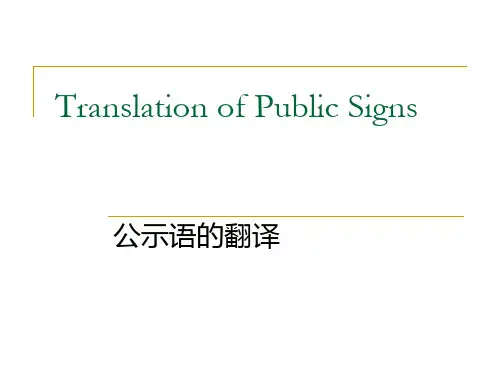
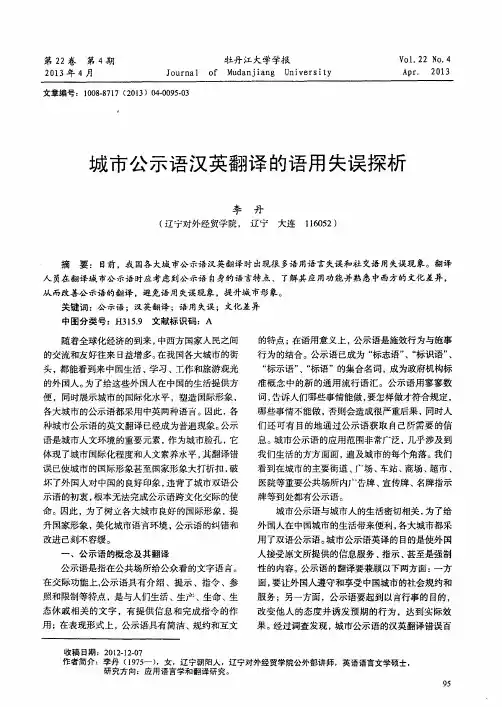
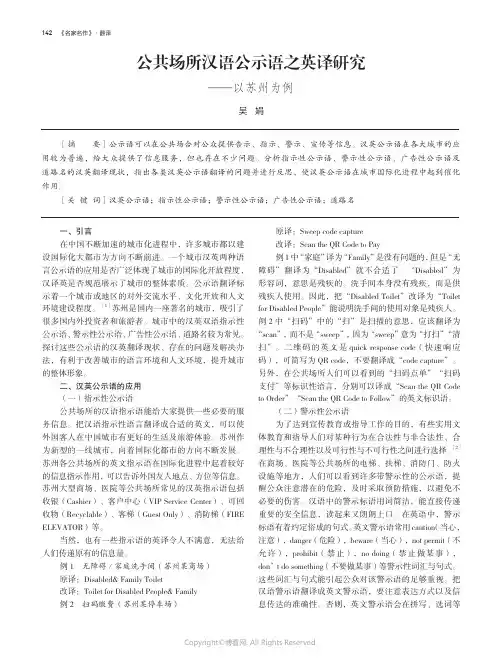
142《名家名作》·翻译一、引言在中国不断加速的城市化进程中,许多城市都以建设国际化大都市为方向不断前进。
一个城市汉英两种语言公示语的应用是否广泛体现了城市的国际化开放程度,汉译英是否规范展示了城市的整体素质。
公示语翻译标示着一个城市或地区的对外交流水平、文化开放和人文环境建设程度。
[1]苏州是国内一座著名的城市,吸引了很多国内外投资者和旅游者。
城市中的汉英双语指示性公示语、警示性公示语、广告性公示语、道路名较为常见。
探讨这些公示语的汉英翻译现状、存在的问题及解决办法,有利于改善城市的语言环境和人文环境,提升城市的整体形象。
二、汉英公示语的应用(一)指示性公示语公共场所的汉语指示语能给大家提供一些必要的服务信息。
把汉语指示性语言翻译成合适的英文,可以使外国客人在中国城市有更好的生活及旅游体验。
苏州作为新型的一线城市,向着国际化都市的方向不断发展。
苏州各公共场所的英文指示语在国际化进程中起着较好的信息指示作用,可以告诉外国友人地点、方位等信息。
苏州大型商场、医院等公共场所常见的汉英指示语包括收银(Cashier)、客户中心(VIP Service Center)、可回收物(Recyclable)、客梯(Guest Only)、消防梯(FIRE ELEVATOR)等。
当然,也有一些指示语的英译令人不满意,无法给人们传递原有的信息量。
例1 无障碍/家庭洗手间(苏州某商场)原译:Disabled& Family Toilet改译:Toilet for Disabled People& Family 例2 扫码缴费(苏州某停车场)原译:Sweep code capture 改译:Scan the QR Code to Pay例1中“家庭”译为“Family”是没有问题的,但是“无障碍”翻译为“Disabled”就不合适了。
“Disabled”为形容词,意思是残疾的。
洗手间本身没有残疾,而是供残疾人使用。
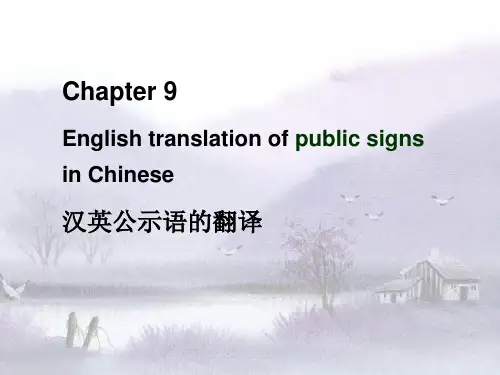
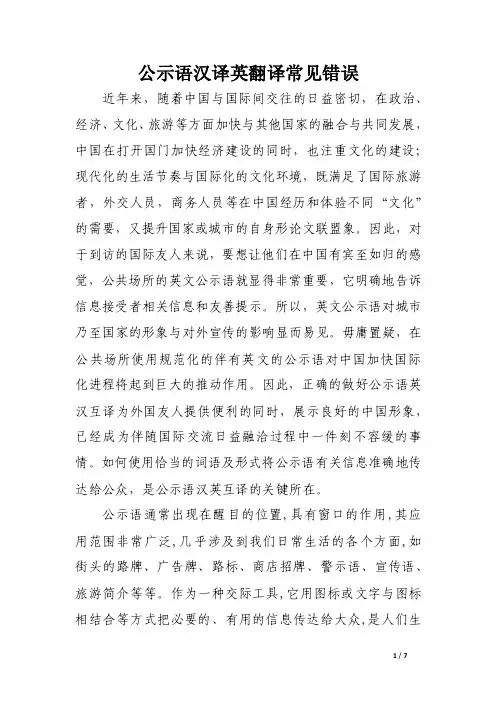
公示语汉译英翻译常见错误近年来,随着中国与国际间交往的日益密切,在政治、经济、文化、旅游等方面加快与其他国家的融合与共同发展,中国在打开国门加快经济建设的同时,也注重文化的建设;现代化的生活节奏与国际化的文化环境,既满足了国际旅游者,外交人员,商务人员等在中国经历和体验不同“文化”的需要,又提升国家或城市的自身形论文联盟象。
因此,对于到访的国际友人来说,要想让他们在中国有宾至如归的感觉,公共场所的英文公示语就显得非常重要,它明确地告诉信息接受者相关信息和友善提示。
所以,英文公示语对城市乃至国家的形象与对外宣传的影响显而易见。
毋庸臵疑,在公共场所使用规范化的伴有英文的公示语对中国加快国际化进程将起到巨大的推动作用。
因此,正确的做好公示语英汉互译为外国友人提供便利的同时,展示良好的中国形象,已经成为伴随国际交流日益融洽过程中一件刻不容缓的事情。
如何使用恰当的词语及形式将公示语有关信息准确地传达给公众,是公示语汉英互译的关键所在。
公示语通常出现在醒目的位臵,具有窗口的作用,其应用范围非常广泛,几乎涉及到我们日常生活的各个方面,如街头的路牌、广告牌、路标、商店招牌、警示语、宣传语、旅游简介等等。
作为一种交际工具,它用图标或文字与图标相结合等方式把必要的、有用的信息传达给大众,是人们生活中不可或缺的帮手。
作为一种特定功能的文本形式,公示语应用历史久远,对其翻译研究意义深远。
在世界各民族的社会、文化、经济发展进程中,准确的公示语翻译对外籍人员来说,具有良好交际效果,可有效地对其规范社会行为,提高生产效率以及优化生存质量等方面。
由于公示语在传递信息中的语言特色和特殊功能,我们应该认清公示语翻译过程中可能出现的问题及背后的原因。
将极大地有助于翻译人员采取正确的翻译方法和翻译策略来解决问题。
要想解决以上问题,我们首先要了解公示语翻译研究趋势。
公示语的翻译研究在国外有比较长的发展历史,现在已经较为成熟和规范;而在中国,针对公示语方面的汉英翻译研究起步较晚,翻译界对此展开的研究还很不够,缺乏体系性和规范性。

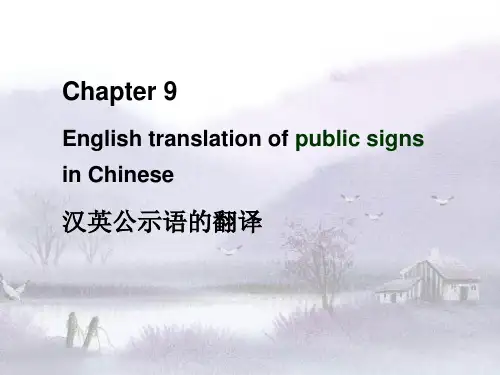
C- E Translation Principles of Public Signs 汉英公示语的翻译原则ReferenceExercise 11. 请勿疲劳驾驶Stay alert,stay alive.2. 搜品廊Shopping Land3. 宾客止步Staff only4.不可回收Non-recyclable5. 请勿触摸Hands Off6.禁止停车No Parking7.公交车专用Buses OnlyExercise 21.南宁是我家,卫生靠大家。
参考译文: Keep our city clean.2.不准乱扔烟头参考译文: No Cigarette Disposal3.无障碍专用通道参考译文: Wheelchair Accessible4.机房重地,非公莫入参考译文: Machine Room Staff OnlyExercise 31.一看二慢三通过参考译文: Slow down, look around, and cross.2.桂林山水甲天下参考译文: East or west, Guiling landscape is the best.3.五讲四美三热爱参考译文: Five Stresses,Four Points of Beauty and Three Aspects of Love.(stress on decorum,manners,hygiene,discipline and morals;beauty of the mind,language,behavior and the environment;love of the motherland,socialism and the Communist Party.)4.来也匆匆去也冲冲参考译文: Come with a rush? Go with a flush!Please flush after you’re through.5.老、弱、病、残、孕专座参考译文: Courtesy Seat。
也谈汉英公示语的翻译译中究竟取“细颗粒”(直译)还是“粗颗粒”(意译)手法, 亦须以“功用”(是否相当)及“语句”(是否通顺)为要。
一例10:有时候一国文字习惯上在某种场合使用很对称的节律而另一国文字在同样场合就用完全不同的节律。
比方从前英国人办沪宁铁路时候在火车里贴的通告说:随地吐痰.最为恶习。
既惹人厌,又碍卫生。
车站月台,尤须清洁。
倘有违犯,面斥莫怪。
八句。
底下的英文“翻译”只说:INTHEINTERESTOFCLEAN- LINESSANDPUBLICHEALTHPASSENGERSARERE- QUESTEDTOREFRAINFROMSPITTINGINTHE TRAINSORWITHINTHESTATIONPREMISES.一长句。
这里头固然还带了有“文明”人教训乡下人的口气,英文就完全是对人平等的措辞,所以翻译的内容不符一半是成心的。
不过中文通告上用对称的节律的确很多,而英文除了故意逗趣的通告多半都用散文的(赵元任,2002:622)。
点评:英汉语言有别,汉英文化有异,“译即逆”因而难免。
由本例观之,公示语之翻译并非形到义随不可,“得意忘形”有时亦不失明智之笔。
从例有关吐痰之公示语,我们联想到香港政府卫生当局曾于各地张贴过的另一则公示语:“随地吐痰乞人恨罚款一千有可能传播肺痊由此起卫生法例要遵行”。
这显然是以打油诗方式教育市民,警告大众勿触犯法例。
要将这首比较特别的公示语忠实、通顺、传神地译为英文,即使意思准确,押韵完美,效果也恐怕会两样,因为西籍人士看了,往往以为开玩笑。
若要起到原文所含之警示之效,应该可以译作:Nospitting.Maximumpenalty$1000(周兆祥,2003:47一48)。
三、任重道远的译者从上文引述及分析不难看出,公示语的翻译十分考究,它对译者的要求实在不低。
那么,我们的译者应怎么做才能译出地道、得体和优美的译文呢?首先,了解英汉公示语各自的语言及文体特点至为重要。
各类公示语翻译各类公示语英文翻译汇总旅游景区的标识语翻译1、湖区水深,注意安全。
Deep water! Beware.2、珍惜文物古迹,勿乱刻乱涂。
No graffiti!3、购票中请当面清点票款,门票售出,恕不退款。
Check the change before you leave. No refund for tickets sold.4、游客必须每人持票入内,废票、伪造票不得入内。
Admission by valid tickets only.5、爱护草坪,足下留情。
Keep off the grass.6、心触一片净土,爱博一片蓝天。
Keep the environment clean.7、禁止摆卖。
No venders.8、六点停止入园。
Last admission: 6:009. 请按门票所示线路参观Please follow the visitor route indicated on your guide ticket.10. 请勿在本区域堆弃垃圾Please refrain from dumpling rubbish in this area.乘车的标识语翻译11.请沿站台过往Pass along the platform please.12.请在乘车前购买好车票Please buy your ticket before you board the train.13.请将机票或登机牌准备好接受安检Please have your ticket or boarding card ready for inspection.14.请协助确保列车准点运行Please help to run trains on time15.请将此座位留给老年人、残疾人和抱孩子的人。
Please offer this seat to elderly or disabled people or those carrying children.16.请仅在紧急情况下使用Please only use in an emergency.17.请您在返回车前先付费Please pay before returning to your car.18.需要帮助请按按钮Please press for assistance.19.请系好安全带Please wear the seatbelt provided.20.存放时请务必索取行李票。
城市公示语的汉英翻译
摘要:
中国不少城市公示语的汉英翻译存在着很大的问题,在全球化的今天,严重影响了城市乃至整个国家在国际上的公共形象。
本文旨在对城市公示语的汉英翻译存在的问题进行分类总结,并重申公示语的翻译原则,以引起人们对城市公示语翻译的广泛重视,从而改善城市公示语的汉英翻译质量。
关键词:公示语翻译原则汉英翻译
引言
在全球发展日新月异的今天,中国在方方面面都在与世界接轨,例如城市公示语就大多采用了中英两种语言,但其翻译质量却存在着很大的问题。
或许公示语的英文翻译仅仅流于形式,不被重视,因为大多数人只看中文公示语,但是我们不要忘了公示语的英文翻译并不是一种摆设,而更多是为在中国的外国人提供方便和帮助,它们也是展示在外国人面前的一张张城市的名片,其翻译质量直接影响到我们在国际上的形象。
或许人们早已注意到城市公示语的汉英翻译存在的问题,只是对公示语的翻译需要一些具体的帮助和理论上的指导。
因此本文旨在对城市公示语汉英翻译存在的问题进行分析总结,并重提公示语的翻译原则,从而在理论上对城市公示语的汉英翻译提供必要的帮助和指导。
一城市公示语汉英翻译存在的常见错误
1 公示语信息被缺省
在实际的翻译过程中,由于译者本身的因素而导致了译文中缺省了一些必要的信息,从而
导致整个公示语译文版本的信息不足。
例如,动物园经常见到不同的动物馆,像虎馆,狮馆,
狼馆等。
其英文翻译大多都是“tiger, lion, wolf”。
译文中少了一个必要的”馆“字,很容
易让外国人产生误解。
外国人可能回认为此标示传达的是“小心老虎,此处有虎”或者是
其他的意思等。
2 公示语原意被歪曲
相对于公示语译文的信息缺省,公示语原意被歪曲的错误就更为严重,它直接导致了公示
语原文与译文指令的截然不同,从而给人造成更大的困惑和误解。
例如,一机动车停车场出
口的旁边挂着一个牌子,上面写着“出口”,其英文翻译为“export”。
其实这是”exit”的误
用,外国人肯定百思不得其解,此处出口什么?出口汽车吗?又如,某商场正门上方挂一
牌子,上面有“欢迎下次光临”,旁边英文为“welcome you again”,见此公示语外国人肯
定心生疑问:我是第一次来,怎么欢迎我两次啊?。
其实“again”在英语中的含义是“once
more”, 就是再来一遍的意思。
还有一大水库的旁边立一牌子,上面写着”小心掉到河里“,
其英文翻译为“carefully fall down to the river!”, 本来是提醒别人别掉进河里,结果变成了
告诉别人要小心地掉进河里。
3 译文语气使用不当
公示语的语气也非常重要,但是很多公示语译文没有很好地传达原文的语气,从而导致语
气不当,或太强或太弱,因而达不到最佳的公示效果。
例如,在很多服务场所经常看到“贵
客止步“的提示,其英文翻译很多情况下被处理成了“guests stop.\ guests go no futher.\”等,
这些英文翻译语气过于生硬,没法传递原文中的礼貌,其实译为“staffs only.”才更为妥当。
又如公示语“小心滑倒”,英文为“don’t fall down.”本来公示语原文想体现人与人之间的关心,但是英文译文却带有命令的语气,因此没有达到交际目的。
其实更好的英文译文为“watch your step.”。
4 译文术语搭配不当
由于译者对一些固定术语搭配结构不熟悉,导致了公示语译文不能达到预期效果,
从而可能带来对译文公示语的误解。
例如“留学生公寓”被英译为了“foreign students dormitory building”,或
许过去还可以接受,但是随着时代的变化它已经过时,继续使用就显的不合时宜。
正确译文应该为“international students building”。
这样的例子比比皆是,例如“眼科医院”(eye hospital ),正确术语应该为“ophthalmology hospital”等。
5 原文与译文文化冲突
由于译者在翻译的过程中没有考虑到不同民族之间的文化差异性,从而导致了公示语原文与译文之间的文化冲突。
例如“此地有恶犬!”(bad dogs!)其实出现这样的英语译文主要在于译者没有考虑到不同民族的文化差异性。
在许多西方国家宠物十分盛行,狗又居宠物之首,是人类的好朋友,是可爱的象征,如果以“恶犬”称呼,让人有一种很不愉快的感觉。
二城市公示语翻译的特点和原则
城市公示语是指在公共场所展示的文字,具有特殊的交际功能,以及提供信息和完成指令的作用。
具体而言,路标、广告、商品说明书、旅游指南、社会宣传、告示等都是公示语。
公示语具有三种主要功能:提示功能、指令功能、参照功能。
城市公示语的翻译必须要考虑到它的功能,只有了解了公示语的具体功能才能提供合乎要求的译文。
下面我们就根据公示语的这些功能来探讨公示语的翻译特点和原则。
1 提示功能
公示语的提示功能就是通过公示语提供的信息使人们明白应该怎样做,或怎样做符合规定。
这种提示不具有强制性,人们可以根据实际情况来选择执行或不执行,因此具有这种功能的公示语翻译用词要委婉、简明,而且句式多样。
例如:“丢失物品店方概不负责”(management not responsible for articles lost or stolen)此公示语提示顾客要保管好个人物品,倘若出现丢失,店方不负责任。
既然告知了可能出现的后果,所以执行与否全由顾客决定。
又如:“此处发现老虎”(tiger sighted)。
2 指令功能
公示语的指令功能是指用公示语的信息来指导人们的行为,具有十分明显的强制效果。
具有指令功能的公示语翻译用词简洁有力,句型结构单一,常常使用祈使句,“no”“forbidden”等这样具有否定含义的词汇也常常出现在译文中。
例如:“请勿吸烟”(no smoking), “请勿接近”(keep out) 等。
3 参照功能
公示语的参照功能是指人们通过公示语的参考性信息可以明确自己的方位,行为方式或目的等。
这类公示语并不直接传达直接规则或强制信息,人们可以根据实际各取所需,有目的地获取公示语提供的信息。
具有参照功能的公示语翻译用词多为名词性词组。
例如:“机场安检”(airport security)只对需要安检的乘客具有参照功能,明确告知他们的具体方位,而对其他人不具有任何意义。
又如:“行李提取处”(baggage claim), “商务中心”(business center) 等。